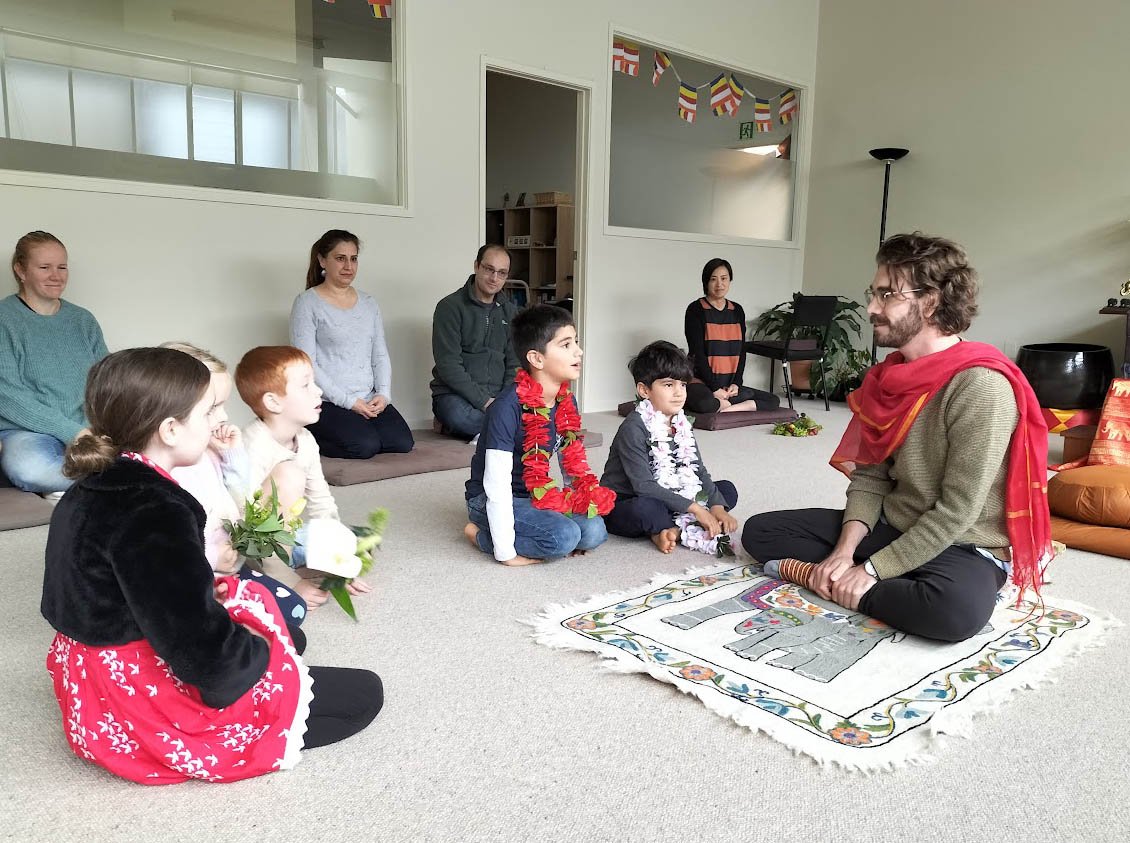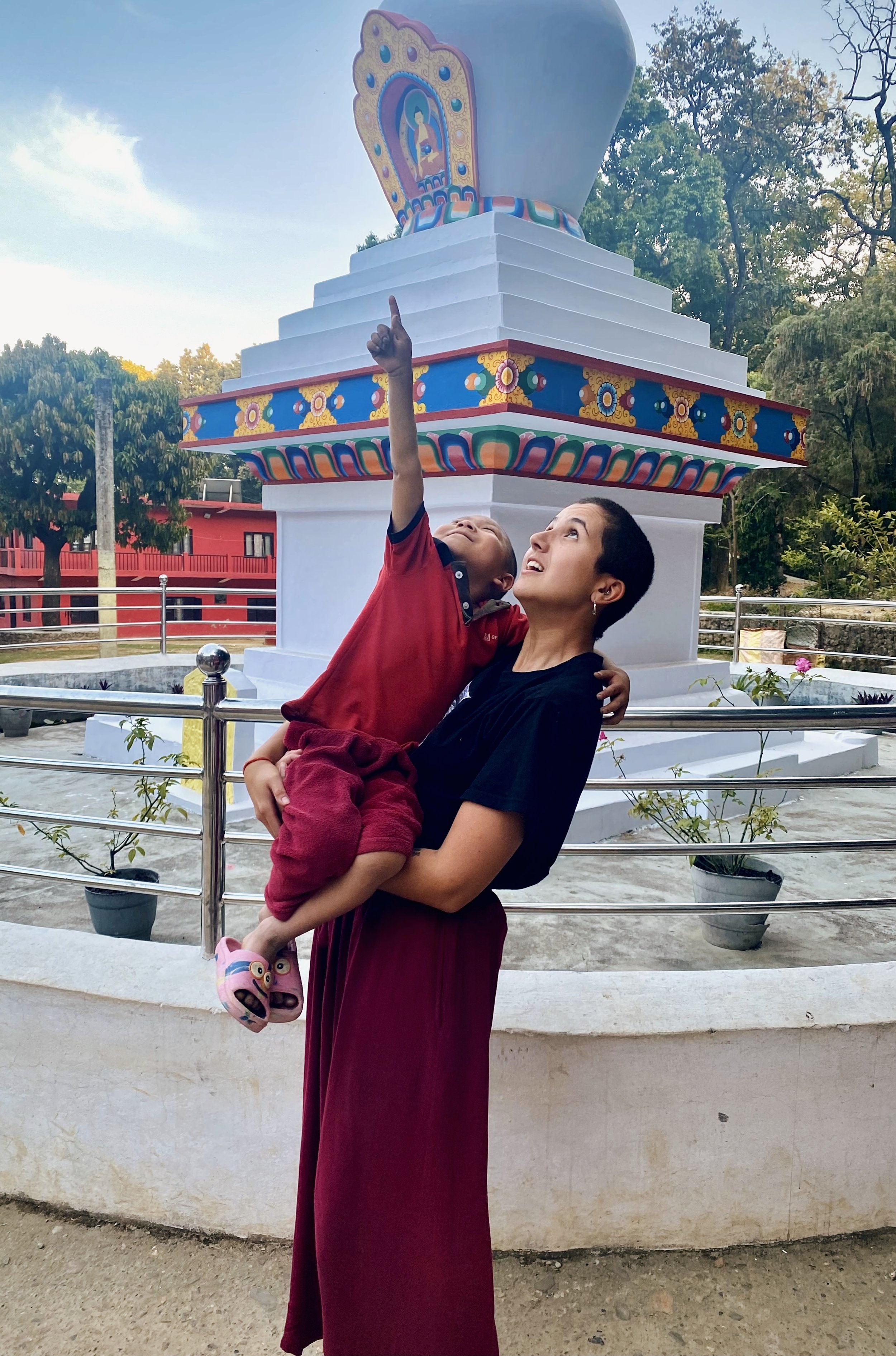AZC Newsletter May 2023
From Amala-roshi: Vesak joy
We just celebrated Vesak and it was heartening to see numbers of both children and adults return to pre-Covid levels. Such annual celebrations naturally draw our attention to the impermanence of things. The adults get older and new generations of children take the places of the ones that have now outgrown the bathing the Baby Buddha ceremony. But at the same time the wonder and delight on people’s faces, young and old, is perennial.
Jonathan retelling the Vesak story this year at the Centre celebrations.
Centre Management: Water
The months since the last half-yearly newsletter have been dominated by various incursions into our building, and our efforts to respond and repair the damage. The major event was the Auckland Anniversary Floods. The Centre weathered the first downpour without issue, but flooding began when a second deluge hit on 1 February. Thanks to the builders who sublet space in the warehouse at the back of the building, we learned early enough on 1 February of the rising waters that we were able to salvage most of our mats and cushions, and move them to dry locations before they were damaged.
Peter Christensen and his son Kem swung quickly into action and installed a pump to move the floodwaters from the driveway and building. Strangely, the pump only lowered the water level a little before reaching a new equilibrium. A second pump was brought in, and in spite of the combined pumps moving 25,000 litres per hour, the water level hardly changed. We were mystified. When a stormwater inspector from the Council eventually came he explained that what we were experiencing was the rising water table. All we could do was wait, and keep pumping, until the aquifer subsided, which it did after an anxious week
Here’s how Watercare explained it:
Groundwater is the term given to water that is present beneath the Earth’s surface. Rainwater naturally soaks into the ground across Auckland and travels from high areas through layers of soil and rock, down towards the coast. The layer of rocks containing the groundwater is known as an aquifer. Groundwater flooding can happen after wet weather. The aquifer fills with water and the water table rises, eventually reaching the surface. There are natural aquifers underneath Auckland including in Mount Eden, Ellerslie, Onehunga and Mount Albert.
So what we actually experienced was the rebirth of a dormant Onehunga spring in our driveway! This explains why the water that flooded the Centre was clear and odourless. Filtered through many layers of rock, it did not stain, so although all the carpet and skirting boards had to be removed and replaced (a big enough task), the walls did not. Thanks to everyone who helped out with the draining, drying, grinding, and sealing of the floors and with all the furniture moves and dusting needed to complete the repairs.
This upheaval followed on the heels of a break-in into the back warehouse space just before Christmas which caused considerable damage and highlighted the need for a new alarm system to cover the whole building, not just the front. Looking after a building is a dynamic, demanding process at times!
Kannon Room awash during the Auckland floods, February 2023.
“Beginning again” concert
Our post-flood celebratory concert was a wonderful mix of song, poetry, art and good cheer. A big thank-you to all who contributed so generously to the evening: our talented performers, our audience, all those who donated items for sale, and all those who gave dana or purchased artwork. Your support for the Centre is hugely appreciated. Funds collected will go towards flood work not covered by our insurance, for example improved drainage.
Balamohan performing at the “Beginning again” concert.
From the Trustees
2022-2023 Financial Report from the Treasurer
The Trustees are pleased to present a brief summary of the draft financial accounts for the 12 months from 1 April 2022 to 31 March 2023. The Centre ended the financial year with an unaudited surplus of $4,305, underpinned by Sangha support and the warehouse rental. This is a substantial improvement over the 2021-2022 loss, despite some unbudgeted costs related to the burglary and the February flooding.
This is a very pleasing result and shows how important the support of all Sangha members are to the financial survival of the centre. Points of interest to note over the 12 month period to 31 March 2023 are:
Revenue
Revenue has declined by 19% over the same period last year –$111,072 versus $137,419 (2021-2022). The reduction in income resulted from a drop in dana (10%) and the loss of income from Dharmagear (no longer operated by the Centre).
Expenses
Fortunately the drop in revenue was offset by a reduction in costs, with expenses declining from $154,029 (2021-2022) to $109,857. The bulk of the savings resulted from a reduction in staffing costs.
Surplus
The Centre’s financials show a surplus of $4,305 in comparison to the 2022 deficit of $16,610, an increase of approximately $21,000 over the same period last year (before interest, depreciation and adjustments).
Summary
A strong focus on cost management combined with the ongoing generosity from Sangha members has underpinned our financial performance this year. We also acknowledge the efforts of Richard as the Centre Manager and Robin as the diligent bookkeeper in keeping the wheels turning.
Peter Christensen, Treasurer
Sangha News
Two Centre members are currently engaging in Buddhist OE. Zara MacNab has been in Nepal for about two months, living and working at Non-Violence World Peace Buddhist Monastery in Daunne. Sammi Stevenson recently traveled to Santa Fe New Mexico where she will participate in Upaya Zen Centre’s Contemplative Residency Programme. We wish Zara and Sammi all the best and a speedy return to their home Sangha.
Zara McNab at the Non-Violence World Peace Buddhist Monastery, Nepal




